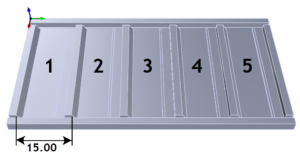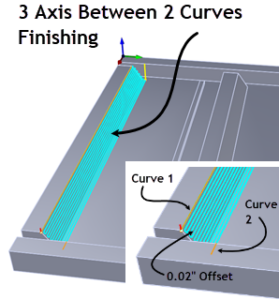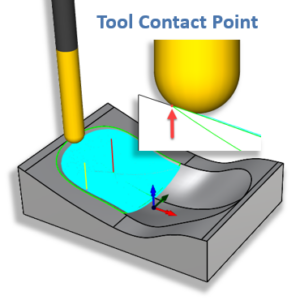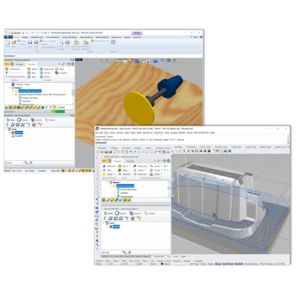What is CAD/CAM?

CAM utilizes the geometric design data present in CAD files as input in the creation of program logic (referred to as cutting tool paths) that will instruct and automate the CNC mill during production. Once the CAM user completes their toolpath logic, they will post-process it into a set of instructions (i.e., a program) for the CNC mill to follow. These instructions strictly adhere to international standards such as ISO 6983. This instruction program is referred to as G-Code named after the subset of operation codes (G00, G01, G03, etc.) used within the standard.
The G-Code program is then transferred from the CAM application to the mill. This is performed either directly using an interface cable, referred to as DNC (Direct Numerical Control) or manually using a USB thumb drive referred to as CNC (Computer Numerical Control). The process of CAM to CNC greatly speeds the production process without trade-offs on design, material strength, and/or accuracy.
Components of CAM Software

At a high level, the CAM software can be categorized into three components. User interface (UI), toolpath generation and toolpath post-processing. Let’s examine these in detail.
User Interface
User Interface, or UI, is the user-facing component of a CAM application. In simpler words, it is anything that a front-end user can see and interact with during the tool path generation, post-processing and CNC manufacturing process.
The UI essentially acts as the common language between the user and the CAM software, which allows the user to generate, simulate and post-process the tool paths that will be put into action. It contains a suite of workflows and dialogs that offers the end-user complete control over the CAM process.
Application Logic
This layer is more complex and involves software components like:
- The database where the specific CAM toolpath parameters are stored and is controlled through an internal database management system (DBMS).
- The CAD 3D modeler, which supplies the CAM component with all of the geometry upon which the machining tool paths are calculated. The CAD modeler also supplies the CAM component with the visualization, simulation, and analysis of the generated tool paths
Post-Processing
Advantages of CAM in Manufacturing

The ability to control cutting machines numerically using computer driven CAM software introduces a host of advantages that are currently being realized within the manufacturing industry. Here are just a few of these benefits:
- Numerically controlled mills and lathes are more accurate and faster than their manually controlled predecessors.
- CAM empowers designers to build prototypes earlier in the design stage allowing more time for product testing and design modifications. Prior to the introduction of CAM, manufacturing prototypes was expensive and usually only performed once in the design cycle.
- Product designs have become more ergonomic and esthetic due in large part to the ability to produce more accurate and complex molds.
- CAM excellerates the manufacture of the assembly line equipment and processes needed to mass produce components and end products, further reducing manufacturing costs.
- Tabletop CNC mills can now produce highly specific designs thanks to the customization capabilities of CAD/CAM software.
Closing Thoughts
About our Guest Author: Peter Jacobs

Peter Jacobs is the Senior Director of Marketing at CNC Masters. He is actively involved in manufacturing processes and regularly contributes his insights for various blogs in CNC machining, 3D printing, rapid tooling, injection molding, metal casting, and manufacturing in genera
More about CNCMasters

CNC Masters of Irwindale, CA, offers the finest CNC machines across the country with incomparable quality and service. If you are a machinist looking for Motion Control to get ahead in product development or a business manager who needs to mass-produce parts faster than machining parts manually, then CNC Masters is the place to go.
We have been in operation for more than 20 years, providing the industry with CNC milling and turning products at competitive prices. The parts for our machines are manufactured domestic and foreign. We build our own complete line of CNC mills and CNC lathes right here in the United States.
More about MecSoft Corporation
MecSoft Corporation was founded in December of 1997 by a team of programmers from Unigraphics Solutions (now Siemens PLM) with the aim of providing affordable yet powerful CNC software solutions to the manufacturing industry. Our founding and operating principles are based upon the notion that our most important partner is our customer. This allows us to:
- Develop quality products that meet or exceed customer needs and to:
- Deliver them at a price to performance value that is unbeatable in the industry,
- Provide excellent customer service and support.
MecSoft Corporation is based in coastal Orange County, CA, south of Los Angeles.

MecSoft Corporation
Corporate Office Address:
34145 Pacific Coast Highway, #616
Dana Point, CA 92629-2808, USA
Phone: 949-654-8163
Support: 949-654-8163 x2
Sales: 949-654-8163 x201
For all other information call us at 949-654-8163. To contact us using our web form, please click here.






